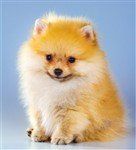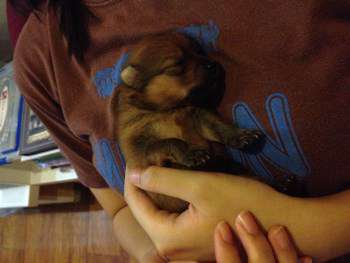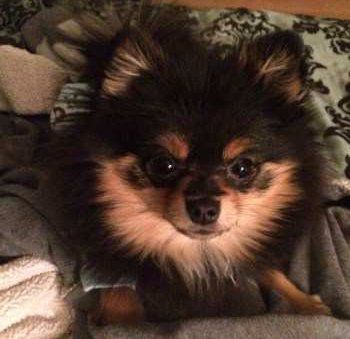Baby Pomeranian
The First Week
A baby Pomeranian is born weighing between 2 and 5 ounces (.05 to .14 kg), undoubtedly a very tiny
size! This very small creature is nothing like the 8 week old Pom that goes to a new home. At this time, he or she has their eyes closed and cannot hear.
The nose, paws and inner ears are a light pink; it will change over to a darker color by 4 to 5 weeks. They have no
teeth and are not able to walk; they can however crawl to move.
They are completely dependent on their mother (dam) for nutrition and warmth. Sometimes, a dam may reject a puppy or if the litter is a good size (4-5 pups), the smallest one may not be able to receive enough suckling time nor be able to cuddle close for warmth.

If this is ever the case, one must either bottle feed or tube feed and provide warmth via a heating pad that is placed under blankets.
The ideal temperature for the room to be for a baby Pomeranian is as so:
- Day 1 to Day 7: 85 to 90 F (29.44 to 32.22 C)
- Day 8 to Day 14: 80 to 85 F (26.67 to 29.44 C)
- Day 15 to Day 21: 75 to 80 F (23.88 to 26.67 C)
- Day 22 to Day 28: 70 to 75 F (21.11 to 23.88 C)
You can bring about this warmth with a combination of a heating pad placed under a blanket (keep it on low, check frequently) and by raising the heating source in your home.
A pup this young has no control their bowels or bladder; the muscles are not fully developed and they need to learn how to control them. During the first couple of weeks, the dam will stimulate the puppy, using her tongue and this causes an automatic reflex to go to the bathroom.
Weeks 1 and 2 - A Time of Growth
During week 2 and by week 3, much has changed. There should have been a consistent and steady
weight gain each day...
It is highly suggested to weigh a newborn each day using a kitchen scale to make sure that there is progress each day.
At this time, eyes are open and they are seeing a whole new world! They are hearing now as well.
This is a cute time, as during these weeks they are learning to walk. It is completely normal for a pup to be wobbly and unsteady on their legs until the age of 4 weeks. However, the quickly master the art of balancing and are soon not only walking, but running around.
The bones are very small and fragile at this time and great care must be taken when picking up and holding a baby Pomeranian.
It is best to use 2 hands; one placed under the bottom of the pup and the other held to support the chest, with the arms comfortably resting over the owner's hand.
One of the dangers of any young puppy
is the possibility of a sudden decrease in blood sugar levels. If this is to happen, it is called hypoglycemia. Sometimes it happens simply because of their small size. However, elements such as stress or not receiving enough food can cause it to happen.
It comes on quickly and one must provide at-home treatment right away before it progresses to coma. One of the best remedies to help in this situation is to rub some honey on the gums of the baby Pomeranian (many sources will recommend Karo syrup, however this has laxative side effects, therefore we do not recommend this).
Putting this onto the gums allows the high sugar content to be quickly absorbed into the bloodstream.
Since this is a serious condition, one should then take their pup to the veterinarian so that levels can be checked with blood tests and an IV can be given if necessary. Symptoms of this are weakness, dizziness, inability to balance, confusion and sleepiness.
Feeding
Between 4 and 5 weeks, there must be a slow yet steady change from nursing from the dam to eating solid food. This is done by creating a mixture of soft food and canine milk replacer, mixed into a soupy mushy consistency and then gradually decreasing the liquid content until the puppy is able to handle a more solid food.
It is important to NOT change the food that the Pom puppy is eating. A rapid change in food type can lead to the above mentioned hypoglycemia and also cause stomach and intestinal duress.
Learning
It is not long before the baby Pomeranian is learning and ingesting a lot of information. At the age of 4, 5 and 6 weeks old, they are learning proper play behavior from the dam and their siblings.
Play biting
is often seen, and when one puppy nips too hard, the other will let out a loud yelp; this is the signal that means "That was too hard!"... often the offending puppy is ignored for a while and both of those actions work well to get the message across about too rough of play.
The dam begins to teach her litter about bathroom procedures without really trying. Once they are a bit older and she has more freedom to move around and leave the house, the pups will see how she goes outside for her needs and often try to mimic what she does.
Detachment
Like any animal and just like humans, there is a certain time when it is 'time to Leave the Nest'. In this case, it is at about 6 weeks old. The dam will stop nursing and pups will be much more independent.
He or she will be in a deep phase of wanting to explore as far as possible, hearing new sounds, seeing new things, smelling new scents, and interacting with new people.
The element of becoming accustomed to people and noises is very important in regard to shaping the personality
of the baby Pomeranian. In regard to people, it may be too overwhelming to deal with a large group all at one time; however it does the puppy good to interact with people of all ages. This is part of the socializing process.
In regard to noises, while one does not want to overwhelm a small puppy with loud noises (as this can cause stress), it is important that they get used to all of the normal household sounds.
Done properly, this will create a puppy that is ready to go to their new home and not be startled or nervous when hearing certain noises.
This normally includes opening doors, the doorbell ringing, the washing machine turn on, the dishwasher cycles, the television, radio and normally toned speaking voices.





